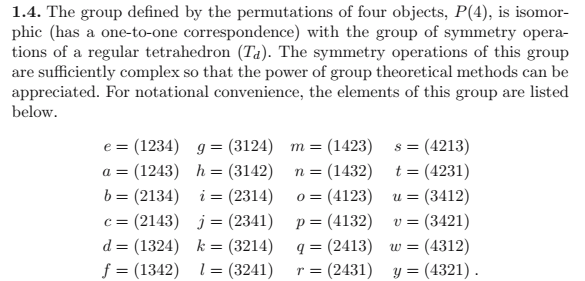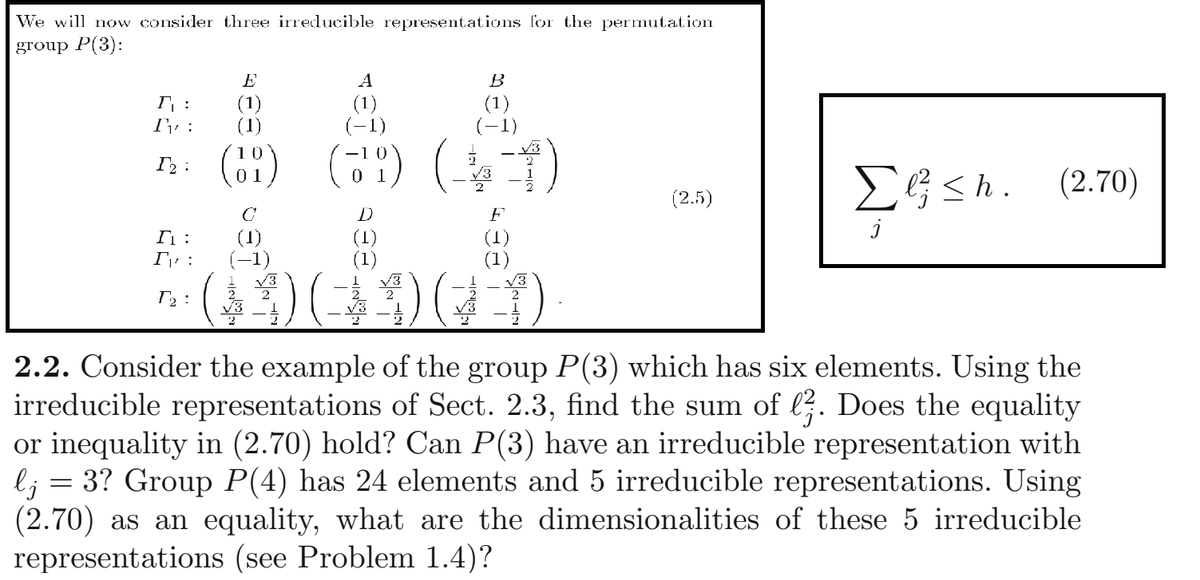We will now consider three irreducible representations for the permutation group P(3): E A B I : (1) (1) (1) (-1) (1) (-1) C) () I2 : EG sh. (2.70) (2.5) F In : (1) (-1) (1) (1) (1) (1) 2.2. Consider the example of the group P(3) which has six elements. Using the irreducible representations of Sect. 2.3, find the sum of l?. Does the equality or inequality in (2.70) hold? Can P(3) have an irreducible representation with l; = 3? Group P(4) has 24 elements and 5 irreducible representations. Using (2.70) as an equality, what are the dimensionalities of these 5 irreducible representations (see Problem 1.4)?
We will now consider three irreducible representations for the permutation group P(3): E A B I : (1) (1) (1) (-1) (1) (-1) C) () I2 : EG sh. (2.70) (2.5) F In : (1) (-1) (1) (1) (1) (1) 2.2. Consider the example of the group P(3) which has six elements. Using the irreducible representations of Sect. 2.3, find the sum of l?. Does the equality or inequality in (2.70) hold? Can P(3) have an irreducible representation with l; = 3? Group P(4) has 24 elements and 5 irreducible representations. Using (2.70) as an equality, what are the dimensionalities of these 5 irreducible representations (see Problem 1.4)?
Elements Of Modern Algebra
8th Edition
ISBN:9781285463230
Author:Gilbert, Linda, Jimmie
Publisher:Gilbert, Linda, Jimmie
Chapter4: More On Groups
Section4.8: Some Results On Finite Abelian Groups (optional)
Problem 14E: Suppose that the abelian group G can be written as the direct sum G=C22C3C3, where Cn is a cyclic...
Related questions
Question

Transcribed Image Text:1.4. The group defined by the permutations of four objects, P(4), is isomor-
phic (has a one-to-one correspondence) with the group of symmetry opera-
tions of a regular tetrahedron (Ta). The symmetry operations of this group
are sufficiently complex so that the power of group theoretical methods can be
appreciated. For notational convenience, the elements of this group are listed
below.
= (4213)
t = (4231)
e%3 (1234) д %3 (3124) т %3 (1423)
n = (1432)
(4123)
p= (4132)
q = (2413) w =
(2431) y =
a = (1243) h = (3142)
b = (2134) i = (2314)
c = (2143) j= (2341)
(3412)
(3421)
(4312)
0 =
= n
v =
%3|
d = (1324) k = (3214)
f = (1342) 1= (3241)
(4321).

Transcribed Image Text:We will now consider three irreducible representations for the permutation
group P(3):
E
A
B
I :
(1)
(1)
(1)
(-1)
(1)
(-1)
(6?) (71) (.
EG <h. (2.70)
(2.5)
F
(1)
(-1)
(1)
(1)
(1)
(1)
T2 :
2.2. Consider the example of the group P(3) which has six elements. Using the
irreducible representations of Sect. 2.3, find the sum of l. Does the equality
or inequality in (2.70) hold? Can P(3) have an irreducible representation with
l; = 3? Group P(4) has 24 elements and 5 irreducible representations. Using
(2.70) as an equality, what are the dimensionalities of these 5 irreducible
representations (see Problem 1.4)?
Expert Solution
This question has been solved!
Explore an expertly crafted, step-by-step solution for a thorough understanding of key concepts.
This is a popular solution!
Trending now
This is a popular solution!
Step by step
Solved in 3 steps with 3 images

Recommended textbooks for you

Elements Of Modern Algebra
Algebra
ISBN:
9781285463230
Author:
Gilbert, Linda, Jimmie
Publisher:
Cengage Learning,

Elements Of Modern Algebra
Algebra
ISBN:
9781285463230
Author:
Gilbert, Linda, Jimmie
Publisher:
Cengage Learning,